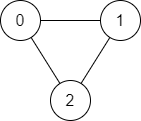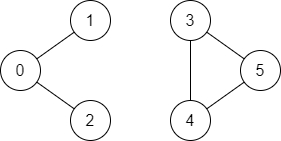1971.Find if Path Exists in Graph
===
###### tags: `Easy`,`DFS`,`BFS`,`Graph`
[1971. Find if Path Exists in Graph](https://leetcode.com/problems/find-if-path-exists-in-graph/)
### 題目描述
There is a **bi-directional** graph with `n` vertices, where each vertex is labeled from `0` to `n - 1` (**inclusive**). The edges in the graph are represented as a 2D integer array `edges`, where each `edges[i]` = [$u_i$, $v_i$] denotes a bi-directional edge between vertex $u_i$ and vertex $v_i$. Every vertex pair is connected by **at most one** edge, and no vertex has an edge to itself.
You want to determine if there is a **valid path** that exists from vertex `source` to vertex `destination`.
Given `edges` and the integers `n`, `source`, and `destination`, return `true` *if there is a **valid path** from `source` to `destination`, or `false` otherwise*.
### 範例
**Example 1:**

```
Input: n = 3, edges = [[0,1],[1,2],[2,0]], source = 0, destination = 2
Output: true
Explanation: There are two paths from vertex 0 to vertex 2:
- 0 → 1 → 2
- 0 → 2
```
**Example 2:**

```
Input: n = 6, edges = [[0,1],[0,2],[3,5],[5,4],[4,3]], source = 0, destination = 5
Output: false
Explanation: There is no path from vertex 0 to vertex 5.
```
**Constraints**:
* 1 <= `n` <= 2 * 10^5^
* 0 <= `edges.length` <= 2 * 10^5^
* `edges[i].length` == 2
* 0 <= $u_i$, $v_i$ <= `n - 1`
* $u_i$ != $v_i$
* 0 <= `source`, `destination` <= `n - 1`
* There are no duplicate edges.
* There are no self edges.
### 解答
#### Javascript
```javascript=
function validPath(n, edges, source, destination) {
// 紀錄每個點能到的點
const graph = [];
for (const [v1, v2] of edges) {
if (graph[v1] === undefined) graph[v1] = [];
if (graph[v2] === undefined) graph[v2] = [];
graph[v1].push(v2);
graph[v2].push(v1);
}
const visited = new Array(n).fill(false);
const stack = [source];
while (stack.length) {
const node = stack.pop();
if (node === destination) return true;
if (visited[node]) continue;
visited[node] = true;
for (const vertex of graph[node]) {
stack.push(vertex);
}
}
return false;
}
```
>[name=Marsgoat][time= Dec 19, 2022]
#### Python
```python=
class Solution:
def validPath(self, n: int, edges: List[List[int]], source: int, destination: int) -> bool:
graph = defaultdict(dict)
self.ans = False
for u, v in edges:
graph[u][v] = 1
graph[v][u] = 1
vis = set()
def dfs(s, d):
if s == d:
self.ans = True
for v in graph[s].keys():
if (s, v) not in vis:
vis.add((s, v))
dfs(v, d)
dfs(source, destination)
return self.ans
```
>[name=Kobe][time= Dec 19, 2022]
```python=
class Solution:
def validPath(self, n: int, edges: List[List[int]], source: int, destination: int) -> bool:
if source == destination:
return True
connected = [source]
visited = [ 0 for x in range(n)]
while len(connected):
cur = connected.pop()
visited[cur]=1
buf =[]
for e in edges:
if cur == e[0] and visited[e[1]]==0 :
buf.append( e[1] )
if cur == e[1] and visited[e[0]]==0:
buf.append( e[0] )
if destination in buf:
return True
connected = buf + connected
#print(buf, visited)
return False
```
>[name=玉山][time= Dec 21, 2022]
#### C#
```csharp=
using System.Collections.ObjectModel;
public class Solution {
public bool ValidPath(int n, int[][] edges, int source, int destination) {
Collection<int>[] graph = CreateGraph(n, edges);
bool[] visited = new bool[n];
Stack<int> stack = new();
stack.Push(source);
while (stack.Count > 0) {
int target = stack.Pop();
if (target == destination) return true;
visited[target] = true;
foreach (var v in graph[target]) {
if (!visited[v]) {
stack.Push(v);
}
}
}
return false;
static Collection<int>[] CreateGraph(int n, int[][] edges) {
Collection<int>[] graph = new Collection<int>[n];
foreach (int i in Enumerable.Range(0, n)) {
graph[i] = new Collection<int>();
}
foreach (int[] edge in edges) {
graph[edge[0]].Add(edge[1]);
graph[edge[1]].Add(edge[0]);
}
return graph;
}
}
}
```
>[name=Jim][time= Dec 19, 2022]
### Reference
[回到題目列表](https://hackmd.io/@Marsgoat/leetcode_every_day)